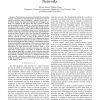Free Online Productivity Tools
i2Speak
i2Symbol
i2OCR
iTex2Img
iWeb2Print
iWeb2Shot
i2Type
iPdf2Split
iPdf2Merge
i2Bopomofo
i2Arabic
i2Style
i2Image
i2PDF
iLatex2Rtf
Sci2ools
INFOCOM
2011
IEEE
2011
IEEE
Throughput and delay scaling of general cognitive networks
—There has been recent interest within the networking research community to understand how performance scales in cognitive networks with overlapping n primary nodes and m secondary nodes. Two important metrics, i.e., throughput and delay, are studied in this paper. We first propose a simple and extendable decision model, i.e., the hybrid protocol model, for the secondary nodes to exploit spatial gap among primary transmissions for frequency reuse. Then a framework for general cognitive networks is established based on the hybrid protocol model to analyze the occurrence of transmission opportunities for secondary nodes. We show that in the case that the transmission range of the secondary network is smaller than that of the primary network in order, as long as the primary network operates in a generalized round-robin TDMA fashion, the hybrid protocol model suffice to guide the secondary network to achieve the same throughput and delay scaling as a standalone network, without harming...
Related Content
| Added | 21 Aug 2011 |
| Updated | 21 Aug 2011 |
| Type | Journal |
| Year | 2011 |
| Where | INFOCOM |
| Authors | Wentao Huang, Xinbing Wang |
Comments (0)

